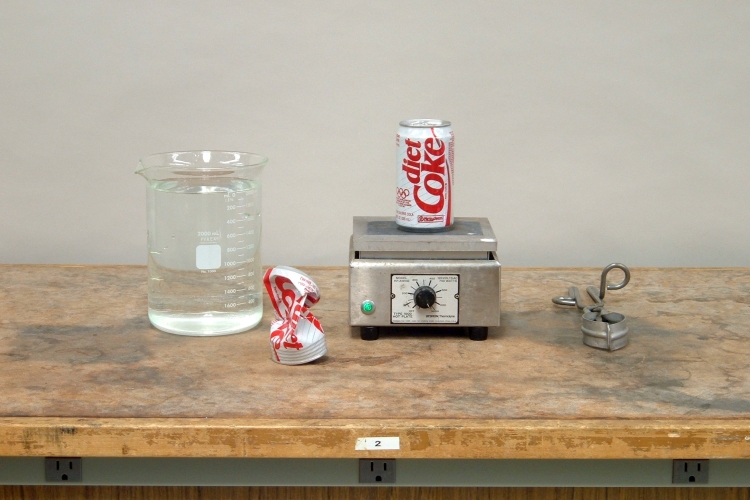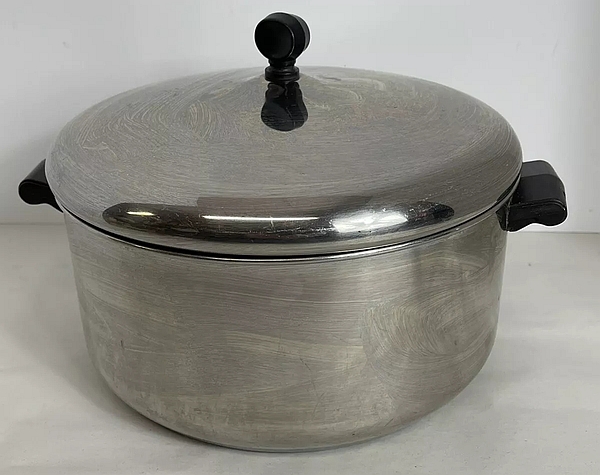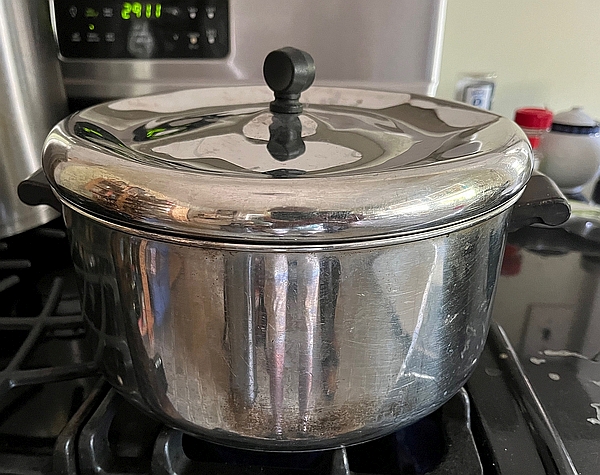
Place the soda can, which has in it a small amount of water, on the hot plate. After a few minutes, the water will boil. When you are sure that steam fills the entire can, with the beaker tongs (at right in the photograph above), grasp the can and quickly invert it and plunge the top of the can into the beaker of water. This quickly condenses the steam, which reduces the pressure inside the can essentially to zero. The air that surrounds the can immediately crushes it, as happened to the can shown near the center of the photograph.
This demonstration shows what happens when a substance, in this case water, undergoes the change from the vapor phase to the liquid phase. In the vapor phase, the average distance between molecules is much greater than that in the liquid phase. When water vapor condenses, there is a thus a dramatic decrease in the volume that the water occupies, and with it, a concommitant decrease in pressure as the volume formerly occupied by the vapor is now essentially evacuated.
When you perform this demonstration, the steam generated by the boiling water at the bottom of the soda can displaces the air in the can, which exits through the opening in the top. For a successful demonstration, you should wait until you are sure that the steam fills the entire volume of the can. At this point, as noted above, when you invert the can and immerse the top in the beaker of room-temperature water, the steam immediately condenses. This happens so quickly that the entire volume of the can, except for the small volume occupied by whatever boiling liquid water is left, is evacuated, and the can collapses under the force generated over the surface of the can by the 1-atmosphere pressure difference between the outside and the inside.
According to the 1967 American Society of Mechanical Engineers (ASME) steam tables, at 212 °F (100 °C), the boiling point of water, the specific volume of the liquid is 0.016719 ft3/lbm, and the specific volume of the steam is 26.799 ft3/lbm. In cm3/g, these are, respectively, 1.04 cm3/g and 1.67 × 103 cm3/g. We see that the specific volume of the steam is about 1,600 times that of the liquid. When the steam condenses, then, it takes up 1/1,600 its original volume. This means that, as noted above, when the steam condenses, the space it had occupied becomes a vacuum. This happens so quickly that when you perform the demonstration, the can is crushed before any significant amount of water can enter from the beaker. Designers and operators of piping systems in which steam circulates, must be very careful to avoid conditions that could cause sudden condensation. See, for example, https://www.plantengineering.com/articles/water-hammer-in-steam-systems-cause-and-effect/.
Some may be tempted to think of this as an example of the decrease in pressure of a gas that occurs when the temperature is decreased. The decrease in temperature, however, from 373 K to 294 K (if we call room temperature 21 °C), would cause the pressure to decrease to about 294/373, or 0.79 times its original value. The resulting pressure difference of about 3 psi between the inside and outside of the can would compress the can, but only by 21%. Once the can reached 0.79 times its original volume, the pressures inside and outside the can would again be equal. The can would be slightly deformed, but it would not be crushed. The essentially 100% change in volume that occurs when the steam condenses to liquid, however, causes the can to be crushed as shown above.
Though one usually need not worry about this phenomenon in most situations, sometimes it can occur unexpectedly as a result of normal activities in the home. During a visit to the house of a family member, I noticed a pot with a rather badly misshapen lid. He had no idea what he or whoever else might have been using the pot had been doing when it happened, but the damage, and the fact that the lid was stuck fast to the pot afterward, give a very good hint. Since the event was unexpected, he did not take a “before” photograph, but he did take a photograph of the pot after it had happened. I was able to find a photograph of a similar pot, taken from an angle not too far from that of the“after” photograph, for comparison. The two are shown below.
At left above is a normal-looking stock pot. At right is the pot that sustained damage to its lid. It is almost certain that someone put some water in the pot, or put something in the pot that when heated would release enough water vapor to fill the pot, turned on the flame under the pot and let it heat to a boil (or to the boiling point of water), and then, either leaving the lid on or having replaced it after momentarily removing it to check the contents of the pot, turned off the flame. Whatever volume was not occupied by liquid or solid matter would have been filled with steam. With the flame off, the pot cooled, and when the temperature decreased to below the boiling point of water, the steam suddenly condensed, leaving a vacuum in the volume it had occupied. The rather large force of the atmosphere over the area of the lid (~1,200 pounds for the 10.25″-diameter pot) was enough to deform the lid downward and press it hard enough against the pot to make a good seal. The owner of the pot remembers that the lid was stuck tightly to the pot, but not how he was finally able to remove it. An easy way should have been to heat the pot again to vaporize the condensed water. This should have increased the pressure inside the pot until it was close enough to atmospheric pressure to make it possible to remove the lid.
References:
1) Weast, Robert C., Ed. CRC Handbook of Chemistry and Physics (Boca Raton, Florida: CRC Press, Inc., 1980) E-21.

